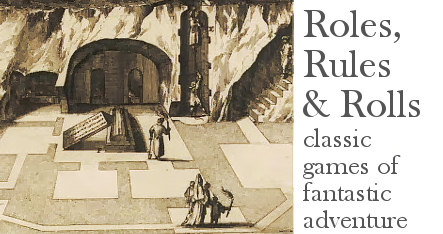Well, no. But with a little common-sense tweaking of the standard D&D combat system, even the most straightforward creature can become an exciting, terrifying combat threat.
The key is close combat. It was Steve Jackson's micro-game Melee - precursor of the GURPS system, and an elegant, d6-based simulation of skirmish combat in its own right - that introduced the rule that two figures could occupy the same space and be locked in close combat, where most long weapons were useless. A less drastic version of this idea for D&D can be found in Ronald Hall's initiative system - someone locked in close combat with an unsuitable weapon would only lose initiative, but still attack normally.
To refresh, here's my application of the idea in my own close combat rules:
 The thing is, I don't use these rules as a DM to their full extent. I probably should, but I've had a soft spot for my players until now. I originally put them in to make players consider taking a variety of weapons - dagger or short sword for close combat, for example. But as dangerous as a guy with a knife in a brawl is, an animal with teeth and claws is much, much worse.
The thing is, I don't use these rules as a DM to their full extent. I probably should, but I've had a soft spot for my players until now. I originally put them in to make players consider taking a variety of weapons - dagger or short sword for close combat, for example. But as dangerous as a guy with a knife in a brawl is, an animal with teeth and claws is much, much worse.A wolf is coming at you. To close, it has to not get hit by your attack, and then it's in there with you. It may even go for the "attack to hold" option in order to knock you down. And when you're on the ground under a predator, you're in a bad way. Your best weapons are useless and its best weapons are in prime working order. If your friends try to help you, they risk hurting you instead.
Things get worse when outnumbered or outflanked. In my system, you can only fend off something advancing to close range if you can hit it. If one wolf engaged you from the front while another attacks from the side or back, you will be in close melee with them in short order. The same goes for spiders. monkeys and stirges dropping from overhead.
For even worse threat, make it so you can get in close without any problems if you're two or more sizes smaller as well as bigger. Giant rats suddenly don't look so pathetic when they're under-running your front lines. If you don't kill them quick, they'll be hotfooting your wizard. Not to mention what happens when something really small decides to climb on you.
With not-so-dumb animals getting into the maneuver and positioning game this way, an attack by a bear or a pack of wolves turns from a toe-to-toe slog into a tense nightmare for players.
Next up: High level combat and why it's only boring in theory.




I really like the idea of these rules, but I'll have to give them a go in practice - like you suggest, it might make 'mundane' animals realistically frightening!
ReplyDeleteRecently read one of Ian Johnson's not-so-recent blog post advising some of the same combat techniques. Though his main thesis was that giant spiders are far more terrifying than generally given credit for:
ReplyDeletehttp://monstroustelevision.blogspot.com/2012/05/stop-ruining-spiders.html?m=0
That's a great analysis. I would say it brings up the more general idea that to be interesting and fearsome, a combat opponent should break the rules in some way.
DeleteEh. Some good ideas, and I have respect for them, but I already figured out animal combat. Where you lost me is at the beginning. Animals are smarter than us in that they usually lay traps. A wolf is not going to come out in the open unless he is making an attack from behind or wants the target to focus on him so that the rest of the pack can make an attack from behind.
ReplyDeleteIn short, animals are smart when it comes to killing and not being killed. I recommend watching discovery channel or animal planet to get a taste.
I second Spazalicious Chaos. Why in the world would you think that animals wouldn't use complicated traps, tactics and flanking maneuvers? Do you think that animal predators stroll up to their intended prey and slap them in the face with a gauntlet and challenge them to a duel? Animal predators combine a physiology made for killing with learned behaviors that are the very definition of cunning.
ReplyDeleteHm, yeah. I guess I shouldn't have said that animals wouldn't use outflanking and positional maneuvering; in fact, I later contradict this with the example of the wolves outflanking a lone armed man. I more meant to rule out "Tucker's Kobolds" style tool-using stratagems - although in a fantasy setting, you may very well end up supporting the right to arm bears ...
ReplyDelete